Recent datasets

The aim of this component of the Reef Rescue Monitoring Program is to assess trends in the concentrations of specific herbicides and pesticides, primarily through routine monitoring at sites (Green Island, Low Isles, Fitzroy Island, Normanby Island, Dunk Island, Orpheus Island, Magnetic Island, Cape Cleveland, Pioneer Bay, Outer Whitsunday, Sarina Inlet, North Keppel Island) within 20km of the Queensland coast. The monitoring year for routine pesticide sampling is from May to April.
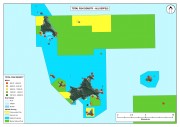
This dataset consists of site and zone means of the percent cover of major benthic categories and the density of fish functional groups on fringing coral reefs of the Keppel Island group, as a result of monitoring surveys carried out in 2015.
This data extract summarises the results of the October 2015 survey of reef communities in the Keppel Island group. The data is a component of a long-term monitoring project that assesses the effects of no-take marine reserve zoning on inshore reefs of the Great Barrier Reef Marine Park.
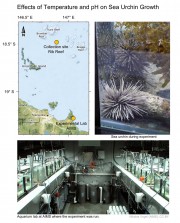
This experiment grew adult Echinometra sp. A sea urchins under four temperature and pH treatments 28 / 7.9, 28 / 8.1, 31 / 7.9, 31 / 8.1 (degrees C, pH) to investigate the interactive effects of warming and acidification on their physiology. These treatments were chosen to match those that may be experienced in the near-future (2100) due to climate change. Each treatment was replicated across 3 aquaria, each with 6 individuals for a total of 72 sea urchins.
Method:
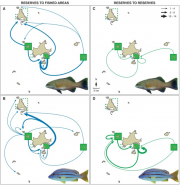
As part of MTSRF Project 4.8.1, this study aimed to assess the benefit of no-take (green) zones as a recruitment source. 1342 adult stripey snapper (Lutjanus carponotatus) from 3 green zones around the Keppel Islands were fin-clipped for genetic analysis and released. Microsatellite markers were used to assign juveniles to one or both parents. From the 483 juveniles collected from 16 sites in both green and blue zones, 140 (~30%) were assigned to one or both parents from the adult sample.

This metadata is a brief overview of the National Environmental Research Program Tropical Ecosystems (NERP TE) Hub and a metadata parent record for all datasets and projects developed as part of this research program.
This dataset consists of one data file (spreadsheet) from a 1 year large tank herbicide degradation experiment in seawater, containing 4 different light and sediment treatments. Each tab contains concentration data at each time point for a single herbicide under each of the four light and sediment conditions.The aim of this study was to conduct a year-long degradation experiment using concentrations of commonly detected herbicides in a series of replicate open tanks.
This dataset consists of 107 days of vessel tracking using the Automatic Identification System (AIS) at 1 hour intervals extracted for the Queensland region from the Spatial@AMSA Historic Vessel Tracking website (AMSA 2013). It has been converted to Shapefile format and contains just under 1 million points.
Presence information for sharks and fish fitted with acoustic transmitters on reefs in the Townsville region. Acoustic receivers are deployed on: Bramble (4), Rib (4), Kelso (2), John Brewer (4), Lodestone (4), Helix (4), Keeper (2), Glow (3), Cotton Shoal (1), Arc (1), Grub (4), Yankee (3), Centipede (2), Wheeler (5), Davies (2), Pinnacle (1) and Little Broadhurst (2) reefs. Transmitter life ranges from 12-30 months. Transmitters report depth data to indicate position of the animal in the water column.
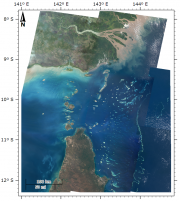
This dataset is a composite of Landsat 5 satellite imagery to produce a cloud free, clear water seamless image of the Torres Strait region. This image includes some of Cape York and PNG, in particular the Fly river. This composite shows clear imagery for marine areas, in particular reefs, larger islands and sand bars.
This image has a resolution of approximately 30 m and a positional accuracy of better than 50 m.
This dataset shows the ocean side boundary of the Great Barrier Reef Marine Park, excluding the inner boundary along the Queensland coastline.
This dataset was derived from the Great Barrier Reef Marine Park Boundary dataset by loading the GBRMPA_BOUNDS_Line.shp (supplied by GBRMPA) into ArcMap then deleting the verticies along the coastline, breaking the original closed line loop.
This dataset is not authorive and was produced for use in the eAtlas. Contact the Spatial Data Centre at GBRMPA for the official boundaries.

This data set describes change in forest attributes over time in response to passive regrowth and biodiverse ecological restoration plantings across the southern Atherton uplands. These data were obtained from four sets of spatially replicated site-types: (1) a chronosequence of 29 passive regrowth sites (1-67 years) on previously forested land with a subsequent period of land use for agriculture (e.g.
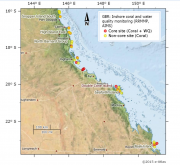
This dataset contains data on carbon chemistry on inshore reefs of the Great Barrier Reef (GBR). Main parameters measured were temperature, total alkalinity and dissolved inorganic carbon. The data was collected six times over two years (September 2011 - June 2012) covering a comprehensive latitudinal range.
The aim of this study was to investigate carbon chemistry on inshore reefs, and compare it to offshore reefs and historical data.
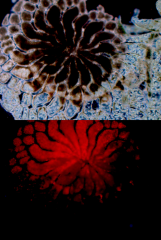
This dataset measures 5 effects of temperature and pH stressors (individual and combined) on tropical Foraminifera. The effects measured are: respiration, survivorship, growth, chl-a content and photochemistry. The study was conducted in 2011 and the data is provided as 5 single sheet spreadsheets.

This dataset consists of one data file from a 16 day aquarium experiment manipulating pH and light level and measuring growth, photosynthesis, calcification and pigment content of Acropora millepora.
The aim of this study was to test the hypothesis that a combined effect of decreased pH and decreased light on physiological responses of the coral is larger than that of each stressor individually.
Method:
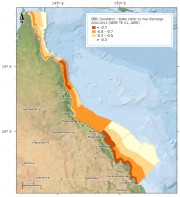
This dataset shows various statistics of photic depth across the Great Barrier Reef (GBR). Data are broken into 35 zones along and across the GBR and photic depth is derived from 11 years of MODIS Aqua data. The data included is:
1. The statistical strength of correlation between standardized photic depth and freshwater discharges the GBR.
2. The mean photic depth and the main physical environmental variables that need to be controlled for when assessing how volumes of river freshwater discharges influence photic depth.
As part of the NERP TE project 2.3 temperature loggers were deployed at 15 sites across Torres Strait to measure the sea temperature. The loggers regularly measure the sea water temperature and record it in their memory. Every year or so the loggers are swapped with new loggers and the recorded data is extracted and recorded in the AIMS Real Time Data Systems database as part of the Australia wide Sea Temperature Observing System.
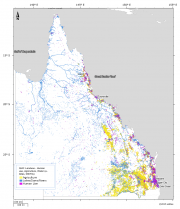
This dataset is subset and aggregation of the current Queensland land use dataset (1999 - 2012) by Queensland Land Use Mapping Program (QLUMP) produced by the Queensland Government. The land use data was classified and aggregated into areas that represent Human Use, Agriculture and Water areas such as lakes and rivers.
The aim of this component of the study was to determine how photosynthetic rates related to growth rates both into terms of skeletal deposition and organic carbon accrual associated with linear extension, and with organic carbon accrual associated with fat deposition or lipid enrichment of existent tissue. The study was based on the coral Acropora millepora located at Lizard Island (-14°40’, 145°27’) and at Heron Island (-23°26', 151°54') in the Great Barrier Reef (GBR) of Australia, with data collected for winter and summer months.
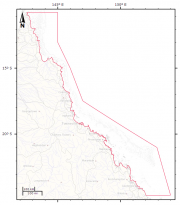
Boundaries of the Great Barrier Reef Marine Park proclaimed under Subsection 31(1) of the Great Barrier Reef Marine Park Act 1975 (CTH). For administrative purposes, the Amalgamated Great Barrier Reef Section is divided into four management areas.
This metadata record was created for the eAtlas and is not authoritative. Please contact GBRMPA for more information. To obtain this dataset go to the GBRMPA spatial information website, download the appropriate data usage agreement and send it through to gis@gbrmpa.gov.au.
This project developed a set of high quality GIS datasets of the emergent and shallow marine features (reef boundaries, reef tops, islands, and cays) of the Coral Sea Marine Park (CSMP). The goal of this mapping was to improve the precision and spatial detail of existing reef maps.



